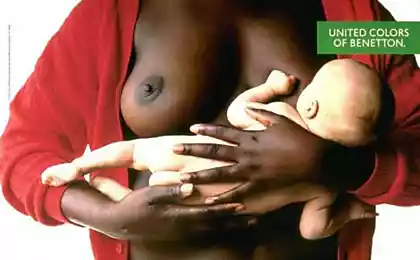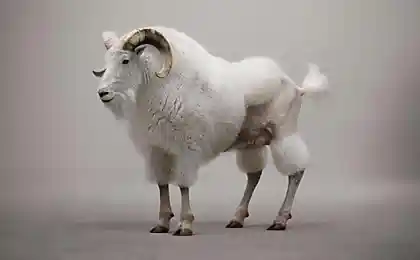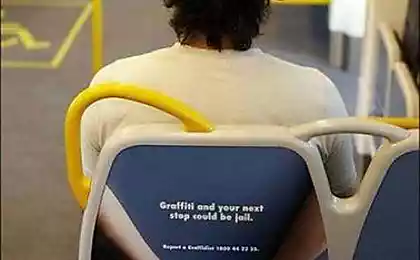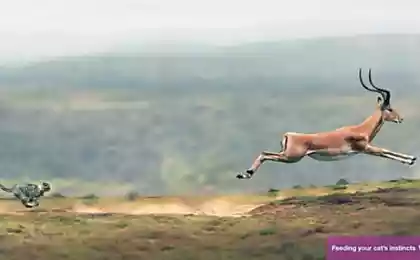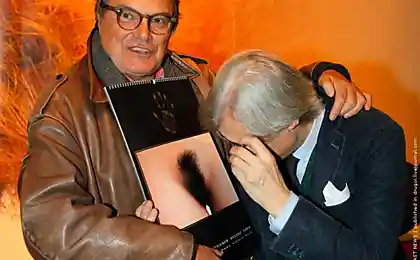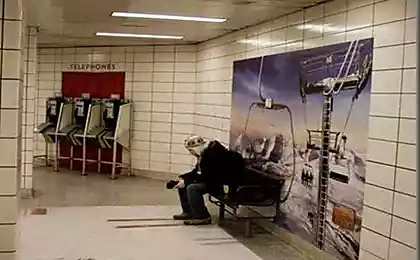926
AdMe.ru portfolio is genius Oliviero Toscani
In the world of advertising Toscani is well known as one of the most controversial fashion photographers. Many of his works which are of a pronounced provocative nature, triggered sharply negative reaction from the Vatican.
Oliviero Toscani name became known in advertising circles, when he was forty. In the early 80-ies of the last century has attracted the attention of his participation in advertising campaigns for Valentino, Esprit, Fiorucci. Oliviero Toscani studied design at the University of Zurich (1961-1965). His original works are often printed the famous fashion magazines. But the world fame came to Tuscany since 1984, when the Italian fashion house Benetton, specializing in the production of youth clothing and accessories offered to lead the photographer to the advertising department of the company.
"I like people that something is being questioned. If you believe something - then it's not work: somewhere you have seen it. The main thing is not to be the first and only ».
While the Italian company Benetton preparing to enter the markets outside Europe, and developed the concept of a marketing offensive. Chief of Luciano Benetton, respecting artist, Oliviero Toscani has promised complete freedom of action, and he agreed to become the creative director of the project.
Many believe that in the spring of 1984 launched an advertising campaign Benetton has opened a new page in the history of modern advertising. The advertising campaign, developed under the direction of Oliviero Toscani, focus to the brand Benetton, on the philosophy of the brand. In 1984, the slogan of the campaign was «All the Solors of the World» (All the colors of the world), and the following year Oliviero Toscani came up with the slogan «United Solors of Benetton» (United Colors "Benetton"). And that is natural to the photographer, the main "mesedzh" campaign were transferred in an international language - the language of photography. The first world-famous photograph of 18-year-old series was a photo in which the chaining children of different races and nationalities were dressed in bright clothes from Benetton, unsold in warehouses since the founding of the company.
The success of the first campaign inspired by Benetton for further experiments. For 18 years at Benetton Toscani chose different themes for an advertising photo shoot, without fear of the most acute global problems: such as racial discrimination, AIDS, war. On billboards fashion house Benetton in different years can be seen: the newly born baby with no more cutting the cord; white baby, clung to his chest a black woman; real people's hearts with the words White, Black and Yellow (say, look, heart and something all the same); Negro with colored eyes; pictured in a series of genitals Mongoloid, Negroid, and the white man; flying multicolored condoms; copulating horses of different colors; a young Catholic priest, a nun kissing a young, etc. Of course, not everyone will come to mind the words of the plot explanation Toscani: "Horses remind us of the spontaneity of nature, that it is becoming more difficult to understand in our artificial world." He was repeatedly taken to court - after aggressive attacks against the largest advertising agencies in Italy. He excommunicated when the Pope saw Toscani photo depicting girl in jeans Jusus Jeans with the biblical quote: "He who loves me, he follows me».
The fashion house Benetton also implemented (with the UN) a strong advertising campaign dedicated to the 50th anniversary of the Declaration of Human Rights. For advertising products on this topic, placed portraits of young people from around the world against the backdrop of the first articles of the Declaration: "All human beings are born free and equal in rights and human dignity ..." Advertisement dedicated to the Declaration of Human Rights, ratified on 10 December 1948, extended in 72 countries, supposedly it saw about 480 million people.
But not all projects were as decently as a joint project with the United Nations. Many of these works Toscani caused shock and, as a result of the scandal. For example, during an exhibition of posters Benetton at the Museum of Modern Art Buenoss Aires authorities demanded to remove one of them (with kissing ministers of Catholic worship). In response, the organizers have withdrawn all the work of the artist. A very significant event: the work Oliviero Toscani are both modern art and the epicenter of the scandal. Toscani himself estimates related to his creativity: "Do not photograph shocking, shocking imprinted on them a reality. People are indignant at the sight of photos of starving children and safely forget about them when these images fade from view. Photos - it is only casts of the reality around us, and my work is precisely the creation of such impressions ».
The photographer claims that provocation can not be determined, since it does not exist as such - there is only the result of people who feel provoked, and in itself a provocation in the photo is directly linked with the times, culture and education. According to the photographer, the provocation of his posters is something positive, since seeing a similar product, a person is provoked into thinking. There are no rules of provocation: it only offers another point of view, which has not yet got into the conventional patterns of behavior. There is no eternal provocation - is only temporary dogmas and symbols, and to confirm this Toscani gives an example: a swastika - a symbol of life, the Nazis turned into a symbol of violence.
The provocative policy of his creative director Luciano Benetton and maintained, and supported the most efficient manner. Luciano Benetton (as a senator of the Italian Parliament) photographed completely naked for the campaign in 1992. Intimate space senator covered a banner reading: «I want my clothes back» (Give me back my clothes).
Undoubtedly, the position of a rebel, a photographer was pretty head of the house Benetton, but above all, he was a businessman and well able to count. Over 18 years of cooperation with Oliviero Toscani's sales increased by 20 times, which is why Luciano Benetton allowed many creative director. There is no doubt largely due to Toscani Benetton became a world-renowned company. But in 1965, Giuliana Benetton and her three brothers - Carlo Luciano and Gilberto - began with a single store in a small town in northern Italy Ponzano. Today they have 7,000 stores in 120 countries around the world (only in China they - 50) and giant supermarkets in 16 major cities around the world. "Benetton" - one of the most famous brands in the world - the trade turnover is about 137 million pounds.
By the way, cooperation Benetton and Toscani has brought them not only a lot of scandals and money, but the UNESCO Prize and the Golden Lion at the Cannes International Advertising Festival.
But it was for the time being, to be exact - before the end of the twentieth century.
«to feel the freedom, does not necessarily sit in tyurme»
Campaign 2000 was the last joint project Toscani and Benetton. It as the posters were used 26 photographic portraits of killers awaiting the death penalty in US custody.
In 1998, Tuscany became acquainted with American professor Speedy Rice, a fanatical supporter of the abolition of the death penalty. Since filing Rice Tanned new theme, Luciano Benetton offered to release a series of photos with faces of people sentenced to death for murder. According to Tuscany, these stories have symbolized a protest against the death penalty. The head of Benetton, never limit the imagination of its creative director, did not do it and this time.
Since Europe abolished the death penalty for "in-kind" Toscani had to go to the United States. In 1999, Toscani with his team got permission to visit and shoot in several US prisons, where prisoners photographed death row. In January 2000, their images have appeared on promotional posters Benetton under a new motto: «We, On Death Row» (The Condemned). And after this scandal broke. Various associations representing the families of victims of crime, protested, saying that Benetton makes heroes murderers, forgetting about their victims. The California legislature has called for a boycott of the Italian company, and five states in the prisons where Toscani shot his subjects threatened to bring legal action. In the end, the court applied only to Benetton, Missouri, as the prison of the State of Oliviero Toscani penetrated ruse: disguised as a journalist.
Working on the project, Oliviero Toscani did not attach much importance to various bits of paper and formally what has been a fatal error in such a litigious country like the United States. Toscani not bothered to get permission to use images of suicide bombers in the open advertising: more than that, he paid two of them a fee for posing. The payment of such fees is a violation of US laws. US law clearly states that the offender is not entitled to receive income from the crime committed.
The litigation lasted until June 2001 and was completed by the fact that the company Benetton was forced to send an apology to the people whose relatives were killed by criminals depicted on posters, as well as to pay a symbolic sum of $ 50 thousand. Local compensation fund for victims of crime.
Advertising campaign, Benetton costing $ 20 million had to quickly collapse. But the most serious blow to the Italian fashion corporations turned rupture of relations with old partners - one of the largest retail companies in the US Sears, Roebuck & Co., which is after the appearance of posters with faces of criminals refused to sell clothes from Benetton. Because of the scandalous advertising in the United States the number of stores of the company, working on franchising with Benetton, reduced by one third.
At the beginning of the scandal guide Benetton tried to pretend that nothing happened. "It is our prerogative - to photograph collections in unexpected places - said Luciano Benetton. - We use the advertising of real people, not stereotypes of beauty. In the foreground we have always put forward the uniqueness ».
Luciano Benetton publicly stated that the financial losses are not marred his relationship with the creative director and chief of the Public Relations Benetton Mark Major, speaking at a press conference, a journalist corrected, noting that the company lost twenty million dollars. "We've spent twenty million dollars", - he said softly Major to the applause of those present.
However, the losses forced Luciano Benetton change their attitude to Oliviero Toscani, and at the end of April 2000 which lasted 18 years, the relationship was interrupted. Benetton, Toscani left moved to the new New York magazine Talk, occupy a position of creative director. Judging by giving them an interview, he did not regret about anything and remembers the years of cooperation with the Italian company only good words. After all, how many successful commercials ever forgotten after only six months, but his stories of the early nineties has not yet been erased from the memory.
Commenting on his departure from Benetton, Oliviero Toscani said: "Fortunately, nothing lasts forever. After all, when something comes to an end, you have an opportunity to engage in new projects. " Among these projects was the Tuscany and the campaign against smoking in 2002 for the World Health Organization.
«One of the main advantages of advertising - its unpredictability»
One of the most successful advertisers, Oliviero Toscani advertising dislikes and considers it a means of influence on the world. Slavs anarchist views of Tuscany could be called utopian, if not for the huge profits from his restless imagination.
Tuscany is able to realize what others only dream. So out of a seemingly utopian dream, a unique school laboratory Benetton's Fabrica. Fabrica was created in 1994 by Luciano Benetton and Oliviero Toscani. For the first time brought together young talented children (under 25 years) - for joint creative experimentation. One of the results of creativity of young - the magazine Colors, which has become an icon of this, if not the Bible of modern design. It disciples Factories continue advertising the line in the "Benetton" after the departure of its creative director.
Oliviero Toscani is possible to write many more. Someday his life and work will be studied in our schools of design. But, in my opinion, the best thing about this phenomenon will tell himself: "I'm a photographer, not the advertiser. I was interested to cross from the world of photography in the world of advertising and mix them. Therefore, I have never used traditional advertising methods. " "I do not accept the American type of advertising when the rollers are conformist character, very mediocre and similar to each other».
When he was reminded that the objective it is in the service of the capitalist group, praising him and bringing him new revenues, he said: "When architect Frank Henry built the building for the headquarters of Coca-Cola, he also worked for Coca -Cola sell more? Or he took advantage of this order to create a new creature? ».
Someday, and on the walls of our schools, teaching the art of advertising, rather than sacramental Leninist "Learn, learn and learn," Oliviero Toscani will quote: "Advertising should mean much more than just selling products. It is the height of cynicism - people perceive solely as consumers, selling them false dreams, assure them that they will be more beautiful if buy a particular product. One of the main advantages of advertising - its unpredictability ».
From an interview in 2002 www.designboom.com
What time of day do you like?
When I wake up.
Where did you hear the news?
The only thing that I read - newspaper. I never read the books.
Where do you work on your projects?
In my head.
For whom do you work?
For God
Do you discuss your work with other photographers?
I usually talk to the farmer. Who lives next door. He knows how to milk the cows fantastic way. I have another friend of the guy who repairs tractors. They are the most creative people I've ever met.
Have you always wanted to become a photographer?
No, I was born an artist.
Describe your style?
I have no style. We all are unique - this is my unique style. I strive to be free, like the cuckoo, which throws its eggs in the nests of other people a lot.
Who are the designers and architects of the past you impressed?
Rudolph Schindler. He is a German by birth, emigrated to the US in the days of the Nazis.
A young?
Young can not be good. Architecture begins with 80 years.
Do you use your advertising campaigns for charitable purposes, or you want to be a lawbreaker?
I make photographs that are buying businesses to increase sales of its products. They pay me for it. The photos I say only what he wanted to say and that's the only thing I can do. We are all servants of the big companies. Once we were the cross, then the swastika, is now Coca-Cola ... The cross, the swastika, and Coca-Cola our hosts.
From Proust Questionnaire www.designboom.com
What I appreciate most in my friends
Their views
The dream of happiness
I do not dream at all
What is the greatest misfortune for me
Being immortal
Who would you like to be
Be those who will look at me dead
Flower, which I like
Tsvetogk evil
My favorite composers
African Musicians
My hero in real life
Sentenced to death
What I hate the most
Lack of self-pity. Compassion (in terms of Buddhism)
Historic character that I hate the most
Politicians
Gift of Nature, which I would like to have
Life
My motto
Live every day as if it's the last day, because one day it will become history. Create life, not destroy it.
Biography:
O.Toskani - son of photojournalist Italian newspaper «Corriere Della Sera».
Born in 1942 in Milan.
In the 1961-1965 period. - I learned the art of photography and design in Zurich. 1982-2000 - creative director of fashion house Benetton.
Since 1990 - editor of «Collors».
Since 1993 - he founded the «Fabrica» - an international center for research in the arts of communication. Winner of 4 Cannes Lions and many other prizes. He lectures in several univesritetah, he has written three books.
via www.propr.com.ua
Oliviero Toscani name became known in advertising circles, when he was forty. In the early 80-ies of the last century has attracted the attention of his participation in advertising campaigns for Valentino, Esprit, Fiorucci. Oliviero Toscani studied design at the University of Zurich (1961-1965). His original works are often printed the famous fashion magazines. But the world fame came to Tuscany since 1984, when the Italian fashion house Benetton, specializing in the production of youth clothing and accessories offered to lead the photographer to the advertising department of the company.
"I like people that something is being questioned. If you believe something - then it's not work: somewhere you have seen it. The main thing is not to be the first and only ».
While the Italian company Benetton preparing to enter the markets outside Europe, and developed the concept of a marketing offensive. Chief of Luciano Benetton, respecting artist, Oliviero Toscani has promised complete freedom of action, and he agreed to become the creative director of the project.
Many believe that in the spring of 1984 launched an advertising campaign Benetton has opened a new page in the history of modern advertising. The advertising campaign, developed under the direction of Oliviero Toscani, focus to the brand Benetton, on the philosophy of the brand. In 1984, the slogan of the campaign was «All the Solors of the World» (All the colors of the world), and the following year Oliviero Toscani came up with the slogan «United Solors of Benetton» (United Colors "Benetton"). And that is natural to the photographer, the main "mesedzh" campaign were transferred in an international language - the language of photography. The first world-famous photograph of 18-year-old series was a photo in which the chaining children of different races and nationalities were dressed in bright clothes from Benetton, unsold in warehouses since the founding of the company.
The success of the first campaign inspired by Benetton for further experiments. For 18 years at Benetton Toscani chose different themes for an advertising photo shoot, without fear of the most acute global problems: such as racial discrimination, AIDS, war. On billboards fashion house Benetton in different years can be seen: the newly born baby with no more cutting the cord; white baby, clung to his chest a black woman; real people's hearts with the words White, Black and Yellow (say, look, heart and something all the same); Negro with colored eyes; pictured in a series of genitals Mongoloid, Negroid, and the white man; flying multicolored condoms; copulating horses of different colors; a young Catholic priest, a nun kissing a young, etc. Of course, not everyone will come to mind the words of the plot explanation Toscani: "Horses remind us of the spontaneity of nature, that it is becoming more difficult to understand in our artificial world." He was repeatedly taken to court - after aggressive attacks against the largest advertising agencies in Italy. He excommunicated when the Pope saw Toscani photo depicting girl in jeans Jusus Jeans with the biblical quote: "He who loves me, he follows me».
The fashion house Benetton also implemented (with the UN) a strong advertising campaign dedicated to the 50th anniversary of the Declaration of Human Rights. For advertising products on this topic, placed portraits of young people from around the world against the backdrop of the first articles of the Declaration: "All human beings are born free and equal in rights and human dignity ..." Advertisement dedicated to the Declaration of Human Rights, ratified on 10 December 1948, extended in 72 countries, supposedly it saw about 480 million people.
But not all projects were as decently as a joint project with the United Nations. Many of these works Toscani caused shock and, as a result of the scandal. For example, during an exhibition of posters Benetton at the Museum of Modern Art Buenoss Aires authorities demanded to remove one of them (with kissing ministers of Catholic worship). In response, the organizers have withdrawn all the work of the artist. A very significant event: the work Oliviero Toscani are both modern art and the epicenter of the scandal. Toscani himself estimates related to his creativity: "Do not photograph shocking, shocking imprinted on them a reality. People are indignant at the sight of photos of starving children and safely forget about them when these images fade from view. Photos - it is only casts of the reality around us, and my work is precisely the creation of such impressions ».
The photographer claims that provocation can not be determined, since it does not exist as such - there is only the result of people who feel provoked, and in itself a provocation in the photo is directly linked with the times, culture and education. According to the photographer, the provocation of his posters is something positive, since seeing a similar product, a person is provoked into thinking. There are no rules of provocation: it only offers another point of view, which has not yet got into the conventional patterns of behavior. There is no eternal provocation - is only temporary dogmas and symbols, and to confirm this Toscani gives an example: a swastika - a symbol of life, the Nazis turned into a symbol of violence.
The provocative policy of his creative director Luciano Benetton and maintained, and supported the most efficient manner. Luciano Benetton (as a senator of the Italian Parliament) photographed completely naked for the campaign in 1992. Intimate space senator covered a banner reading: «I want my clothes back» (Give me back my clothes).
Undoubtedly, the position of a rebel, a photographer was pretty head of the house Benetton, but above all, he was a businessman and well able to count. Over 18 years of cooperation with Oliviero Toscani's sales increased by 20 times, which is why Luciano Benetton allowed many creative director. There is no doubt largely due to Toscani Benetton became a world-renowned company. But in 1965, Giuliana Benetton and her three brothers - Carlo Luciano and Gilberto - began with a single store in a small town in northern Italy Ponzano. Today they have 7,000 stores in 120 countries around the world (only in China they - 50) and giant supermarkets in 16 major cities around the world. "Benetton" - one of the most famous brands in the world - the trade turnover is about 137 million pounds.
By the way, cooperation Benetton and Toscani has brought them not only a lot of scandals and money, but the UNESCO Prize and the Golden Lion at the Cannes International Advertising Festival.
But it was for the time being, to be exact - before the end of the twentieth century.
«to feel the freedom, does not necessarily sit in tyurme»
Campaign 2000 was the last joint project Toscani and Benetton. It as the posters were used 26 photographic portraits of killers awaiting the death penalty in US custody.
In 1998, Tuscany became acquainted with American professor Speedy Rice, a fanatical supporter of the abolition of the death penalty. Since filing Rice Tanned new theme, Luciano Benetton offered to release a series of photos with faces of people sentenced to death for murder. According to Tuscany, these stories have symbolized a protest against the death penalty. The head of Benetton, never limit the imagination of its creative director, did not do it and this time.
Since Europe abolished the death penalty for "in-kind" Toscani had to go to the United States. In 1999, Toscani with his team got permission to visit and shoot in several US prisons, where prisoners photographed death row. In January 2000, their images have appeared on promotional posters Benetton under a new motto: «We, On Death Row» (The Condemned). And after this scandal broke. Various associations representing the families of victims of crime, protested, saying that Benetton makes heroes murderers, forgetting about their victims. The California legislature has called for a boycott of the Italian company, and five states in the prisons where Toscani shot his subjects threatened to bring legal action. In the end, the court applied only to Benetton, Missouri, as the prison of the State of Oliviero Toscani penetrated ruse: disguised as a journalist.
Working on the project, Oliviero Toscani did not attach much importance to various bits of paper and formally what has been a fatal error in such a litigious country like the United States. Toscani not bothered to get permission to use images of suicide bombers in the open advertising: more than that, he paid two of them a fee for posing. The payment of such fees is a violation of US laws. US law clearly states that the offender is not entitled to receive income from the crime committed.
The litigation lasted until June 2001 and was completed by the fact that the company Benetton was forced to send an apology to the people whose relatives were killed by criminals depicted on posters, as well as to pay a symbolic sum of $ 50 thousand. Local compensation fund for victims of crime.
Advertising campaign, Benetton costing $ 20 million had to quickly collapse. But the most serious blow to the Italian fashion corporations turned rupture of relations with old partners - one of the largest retail companies in the US Sears, Roebuck & Co., which is after the appearance of posters with faces of criminals refused to sell clothes from Benetton. Because of the scandalous advertising in the United States the number of stores of the company, working on franchising with Benetton, reduced by one third.
At the beginning of the scandal guide Benetton tried to pretend that nothing happened. "It is our prerogative - to photograph collections in unexpected places - said Luciano Benetton. - We use the advertising of real people, not stereotypes of beauty. In the foreground we have always put forward the uniqueness ».
Luciano Benetton publicly stated that the financial losses are not marred his relationship with the creative director and chief of the Public Relations Benetton Mark Major, speaking at a press conference, a journalist corrected, noting that the company lost twenty million dollars. "We've spent twenty million dollars", - he said softly Major to the applause of those present.
However, the losses forced Luciano Benetton change their attitude to Oliviero Toscani, and at the end of April 2000 which lasted 18 years, the relationship was interrupted. Benetton, Toscani left moved to the new New York magazine Talk, occupy a position of creative director. Judging by giving them an interview, he did not regret about anything and remembers the years of cooperation with the Italian company only good words. After all, how many successful commercials ever forgotten after only six months, but his stories of the early nineties has not yet been erased from the memory.
Commenting on his departure from Benetton, Oliviero Toscani said: "Fortunately, nothing lasts forever. After all, when something comes to an end, you have an opportunity to engage in new projects. " Among these projects was the Tuscany and the campaign against smoking in 2002 for the World Health Organization.
«One of the main advantages of advertising - its unpredictability»
One of the most successful advertisers, Oliviero Toscani advertising dislikes and considers it a means of influence on the world. Slavs anarchist views of Tuscany could be called utopian, if not for the huge profits from his restless imagination.
Tuscany is able to realize what others only dream. So out of a seemingly utopian dream, a unique school laboratory Benetton's Fabrica. Fabrica was created in 1994 by Luciano Benetton and Oliviero Toscani. For the first time brought together young talented children (under 25 years) - for joint creative experimentation. One of the results of creativity of young - the magazine Colors, which has become an icon of this, if not the Bible of modern design. It disciples Factories continue advertising the line in the "Benetton" after the departure of its creative director.
Oliviero Toscani is possible to write many more. Someday his life and work will be studied in our schools of design. But, in my opinion, the best thing about this phenomenon will tell himself: "I'm a photographer, not the advertiser. I was interested to cross from the world of photography in the world of advertising and mix them. Therefore, I have never used traditional advertising methods. " "I do not accept the American type of advertising when the rollers are conformist character, very mediocre and similar to each other».
When he was reminded that the objective it is in the service of the capitalist group, praising him and bringing him new revenues, he said: "When architect Frank Henry built the building for the headquarters of Coca-Cola, he also worked for Coca -Cola sell more? Or he took advantage of this order to create a new creature? ».
Someday, and on the walls of our schools, teaching the art of advertising, rather than sacramental Leninist "Learn, learn and learn," Oliviero Toscani will quote: "Advertising should mean much more than just selling products. It is the height of cynicism - people perceive solely as consumers, selling them false dreams, assure them that they will be more beautiful if buy a particular product. One of the main advantages of advertising - its unpredictability ».
From an interview in 2002 www.designboom.com
What time of day do you like?
When I wake up.
Where did you hear the news?
The only thing that I read - newspaper. I never read the books.
Where do you work on your projects?
In my head.
For whom do you work?
For God
Do you discuss your work with other photographers?
I usually talk to the farmer. Who lives next door. He knows how to milk the cows fantastic way. I have another friend of the guy who repairs tractors. They are the most creative people I've ever met.
Have you always wanted to become a photographer?
No, I was born an artist.
Describe your style?
I have no style. We all are unique - this is my unique style. I strive to be free, like the cuckoo, which throws its eggs in the nests of other people a lot.
Who are the designers and architects of the past you impressed?
Rudolph Schindler. He is a German by birth, emigrated to the US in the days of the Nazis.
A young?
Young can not be good. Architecture begins with 80 years.
Do you use your advertising campaigns for charitable purposes, or you want to be a lawbreaker?
I make photographs that are buying businesses to increase sales of its products. They pay me for it. The photos I say only what he wanted to say and that's the only thing I can do. We are all servants of the big companies. Once we were the cross, then the swastika, is now Coca-Cola ... The cross, the swastika, and Coca-Cola our hosts.
From Proust Questionnaire www.designboom.com
What I appreciate most in my friends
Their views
The dream of happiness
I do not dream at all
What is the greatest misfortune for me
Being immortal
Who would you like to be
Be those who will look at me dead
Flower, which I like
Tsvetogk evil
My favorite composers
African Musicians
My hero in real life
Sentenced to death
What I hate the most
Lack of self-pity. Compassion (in terms of Buddhism)
Historic character that I hate the most
Politicians
Gift of Nature, which I would like to have
Life
My motto
Live every day as if it's the last day, because one day it will become history. Create life, not destroy it.
Biography:
O.Toskani - son of photojournalist Italian newspaper «Corriere Della Sera».
Born in 1942 in Milan.
In the 1961-1965 period. - I learned the art of photography and design in Zurich. 1982-2000 - creative director of fashion house Benetton.
Since 1990 - editor of «Collors».
Since 1993 - he founded the «Fabrica» - an international center for research in the arts of communication. Winner of 4 Cannes Lions and many other prizes. He lectures in several univesritetah, he has written three books.
via www.propr.com.ua
Whistle team was not! Oppressed people of the Balkans in the Argentine advertising Fiat
"Outstanding Advertising". Commercials-contenders for the Emmy-2007

